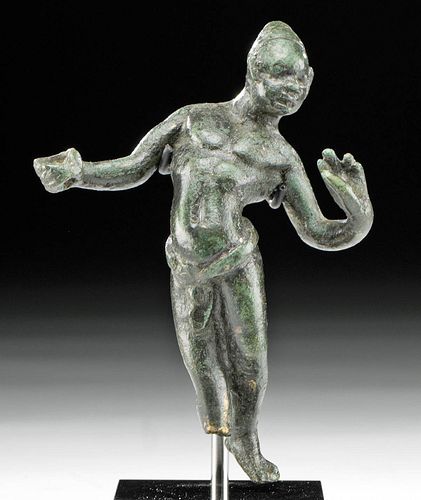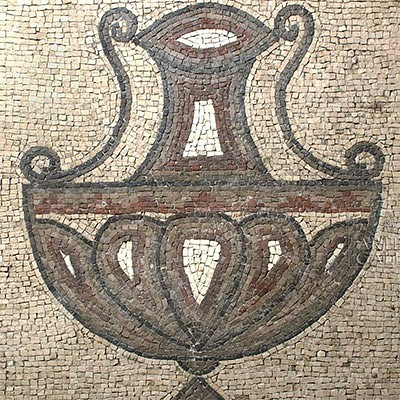Roman Leaded Copper Male Nubian Dancer Figure
Lot 64
About Seller
Artemis Fine Arts
686 S Taylor Ave, Ste 106
Louisville, CO 80027
United States
Selling antiquities, ancient and ethnographic art online since 1993, Artemis Gallery specializes in Classical Antiquities (Egyptian, Greek, Roman, Near Eastern), Asian, Pre-Columbian, African / Tribal / Oceanographic art. Our extensive inventory includes pottery, stone, metal, wood, glass and textil...Read more
Categories
Estimate:
$2,400 - $3,600
Absentee vs Live bid
Two ways to bid:
- Leave a max absentee bid and the platform will bid on your behalf up to your maximum bid during the live auction.
- Bid live during the auction and your bids will be submitted real-time to the auctioneer.
Bid Increments
| Price | Bid Increment |
|---|---|
| $0 | $25 |
| $300 | $50 |
| $1,000 | $100 |
| $2,000 | $250 |
| $5,000 | $500 |
| $10,000 | $1,000 |
| $20,000 | $2,500 |
| $50,000 | $5,000 |
| $100,000 | $10,000 |
| $200,000 | $20,000 |
About Auction
By Artemis Fine Arts
Sep 22, 2020
Set Reminder
2020-09-22 12:00:00
2020-09-22 12:00:00
America/New_York
Bidsquare
Bidsquare : Antiquities - Egypt, Greece, Italy, Near East
https://www.bidsquare.com/auctions/artemis-gallery/antiquities---egypt-greece-italy-near-east-5663
Featuring Egyptian, Greek, Roman, Etruscan & Near Eastern art. If you love the classics, this is the sale for you. All artifacts offered for sale have been legally acquired, are legal to sell and are guaranteed to be as described. In-house shipping for your convenience. Artemis Fine Arts info@artemisfinearts.com
Featuring Egyptian, Greek, Roman, Etruscan & Near Eastern art. If you love the classics, this is the sale for you. All artifacts offered for sale have been legally acquired, are legal to sell and are guaranteed to be as described. In-house shipping for your convenience. Artemis Fine Arts info@artemisfinearts.com
- Lot Description
Roman, Imperial Period, ca. 1st to 3rd century CE. A fascinating cast-leaded-copper figure of an African male who would have been known as an Ethiopian (Aethiops) or Nubian by the Romans. The figure stands in a dynamic pose that balances on his right foot with his left lightly sweeping behind, his torso leaning dramatically to the left with his left arm bent and bearing an open hand. The perforation in his right hand was perhaps meant to hold a staff or a performative prop such as a drinking vessel, and his muscular physique is clothed with only a knotted loincloth. The dancer's physiognomy is of characteristic African origin with broad ears, puffy lips, and bulging eyes presented beneath a conical hat. Mottled layers of green, brown, and russet patina have formed across this fine example of Roman figural artistry! Size: 2.8" W x 3.5" H (7.1 cm x 8.9 cm); 4.4" H (11.2 cm) on included custom stand.
The Romans had extensive contacts with people from Saharan and sub-Saharan Africa (in addition to variously occupying land in Egypt and western North Africa). Gold, food, spices, slaves, textiles, coinage, and even exotic animals were part of the robust trade between these regions. Some Africans lived in Rome, and some notable examples ascended to high social status. Well-read Romans regarded the kingdom of Ethiopia - which they used to refer to everything south of Egypt - as a place to be respected. However, in Roman mythology and literature, black skin was a sign of an inhabitant of the Underworld - for example, Charon is described not only as having black skin, but also as having the facial features of an Aethiops by multiple Classical authors, including Ovid, Pliny, and Virgil. Actual African and Egyptian performers played theatrical roles of Underworld characters, and according to Cassius Dio, Emperor Domitian (r. 81-96 CE) threw a dinner party for Senators he disliked where he made his adolescent slaves paint themselves black to represent the Underworld in order to terrify his guests. What Romans intended by their artistic depictions of Africans is unclear, and remains a point of research and debate.
Provenance: private East Coast, USA collection; ex-Collins collection, California, USA 1980s
All items legal to buy/sell under U.S. Statute covering cultural patrimony Code 2600, CHAPTER 14, and are guaranteed to be as described or your money back.
A Certificate of Authenticity will accompany all winning bids.
We ship worldwide and handle all shipping in-house for your convenience.
#152933Repairs to left elbow, three fingers on left hand, right arm at shoulder, and left foot at ankle, with light resurfacing and minor adhesive residue along break lines. Loss to original right ankle and foot as shown. Abrasions and minor nicks to legs, body, fingers, and head, with light softening to some finer details, and light encrustations within some recessed areas. Wonderful patina throughout.Condition
- Shipping Info
-
All shipping is handled in-house for your convenience. Your invoice from Artemis Gallery will include shipping calculation instructions. If in doubt, please inquire BEFORE bidding for estimated shipping costs for individual items.
-
- Buyer's Premium



 EUR
EUR CAD
CAD AUD
AUD GBP
GBP MXN
MXN HKD
HKD CNY
CNY MYR
MYR SEK
SEK SGD
SGD CHF
CHF THB
THB














